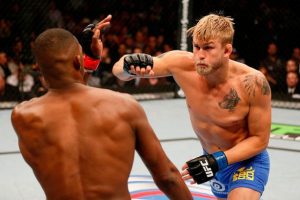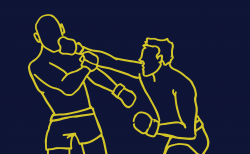A lot of things changed for the UFC this year; the franchise’s $4.2 billion purchase put a price on the cultural impact that the franchise has made since its founding in 1993. This goes beyond what anyone could have imagined. At “UFC 2: No Way Out” the single cash prize was $60,000. This year the UFC surpassed previous records with a $3,000,000 purse to the victor of UFC 202. The sport has spiked in viewership this year, after the seemingly permanent plateau in ratings following its move to FOX in 2011. Poorly constructed pay-per-view events, plagued by uninteresting fights and endless plagues of injury dropouts, and a declining reality show gave hints that the UFC wouldn’t have a home on primetime. However, the league’s rebirth can be attributed to one star at the center of it all, the recipient of that $3,000,000 purse, Conor McGregor. The explosive, fervent Irish boxer turned karate virtuoso has brought UFC back into the spotlight.
The UFC’s most recent event, UFC 205, on Nov. 12 exemplifies how UFC has changed in just this year alone. The franchise’s first ever New York City event, due to the recent lifting of a legal ban on MMA competitions in the city, featured Featherweight Champion Conor McGregor, fulfilling his promise to come after the Lightweight belt, held by Eddie Alvarez. Breaking Madison Square Garden’s gate earnings by $5,000,000 and UFC’s pay-per-view buys record by over one million. One more precedent was set, as a tight left hook made McGregor the first fighter 23 years of UFC to ever hold two belts simultaneously.
McGregor is known for his impeccable suits and a swaggering attitude to match. Spectators are used to his antics, making phallic insults towards Chad Mendes or yelling “p*ssy” at Jose Aldo in Portuguese (Aldo’s native tongue) are just some of the ways he gets under his opponent’s’ skin. He arrived to 205 weigh-ins in full form: twenty minutes late and sporting a white mink coat. He smiled wildly as he was carried away by security, still swinging in scrappy Irish fashion against a squared-up Eddie Alvarez. But his behavior was different after his nearly textbook victory by KO. In the past he has vehemently averred that he is the money machine of the UFC, belt or otherwise losing to him is any fighter’s best payday, but the two-belt champion took on a somber tone.
He said that he now plans to take some time off from fighting, awaiting the birth of his child.
“When I’m looking at what they’re [the UFC as a whole] taking in… Bring me on board, for real, not just as this,” he said. “I need to be set for life with this. If you want me to be truly in on this, then I need to be all in on this. Proper, as an owner, have an equity stake in the company.”
And McGregor’s demands may be deserving of Dana White’s ear. McGregor has arguably become the face of the UFC. His instigated grudge matches fare far better than most championship fights. His four fights from this year account for four of the league’s top seven most viewed events, and have drawn massive attention to Fox’s budding new sports channel FOX Sports 1.
The better question, however, is why? Plenty of people can fight efficiently, winning at event after event. Dan Cormier has a better record than McGregor, yet he is only spoken about in relation to the “Will they, Won’t they?” of a perpetually delayed rematch with Jon Jones. McGregor, however, is bold, bordering on audacious, in personality and fighting style, generating a sense of nostalgia for the stylistic diversity and perhaps the sheer mayhem and UFC of days long gone, while giving the league something it has never fully had, a plotline.
***
“There are no rules,” read the UFC’s original tagline. You could kick someone while they were down or even pull hair. There were no time limits or weight classes, fights only ended with the surrender or knockout of one contender, and the victor would generally have to fight again later that same night. It had that can’t-look-away-from-a-train-wreck type of appeal as fists and feet clacked against heads. Beyond its barbarism, it was exotic. At UFC 3 (1994) the 200 lb. Keith Hackney was dubbed “The Giant Killer” when he felled Emmanuel Yarborough, 600+ pound Sumo Wrestler from New Jersey, using only Taekwondo and Karate to defend himself.
It was like the movies, a real life Bloodsport where you could decide who was your personal Van Damme fighting against a gathering of masters drawn from around the globe. Fighters came from all walks of life: American boxers sporting fat gloves and flashy shorts were being choked out by gi-wearing Brazilians. Neither had ever really heard of the other until they were locked together in a cage.
There were heroes; the Gracie v. Shamrock rivalry fueled the early years of UFC fighting. The stoic Brazilian against the all-American kickboxer in a speedo and wrestling boots fueled the narrative of Orientalism vs. Americana, intricate technique versus muscular strength. The various stories lived on: Matt Hughes, the good natured midwestern wrestler would slam KO the cocky villain.
The UFC has always understood the importance of having fighters you love and fighters you hate. White and the league’s founders depended heavily on the Huntington Beach school to supply their franchise with menacing, square-jawed strongmen like Tank Abbott or Tito Ortiz.
The formula was simple: eye-catching, novel violence and heroes versus villains. The stories, however, remained the same. The good guy (cough cough Lyoto Machida, George Saint-Pierre) would beat the bad guy (cough cough Thiago Silva, Matt Serra), and it would fade away into a mottled pile of past attempts at expired, prearranged rivalries that the league hoped would just naturally fall into place.
The shambolic narrative of the sport became worse following the move from Spike to FOX in 2011. Mainstream viewership saw through the UFC’s flimsy structure, with Mike and Molly reruns drawing higher viewership as far into the UFC’s run as Spring 2014. Attempts to draw in viewership became desperate. Bafflingly, WWE easily dominated over “real fighting” on major networks. The hero-villain complex was ceaselessly perpetuated in a dry and endless cycle, possibly the finest example being the incorporation of backyard haymaker-thrower/viral icon Kimbo Slice, bringing Abbott out of retirement to hack away at each other.
Talented fighters lacked the charisma. Despite his astounding abilities, Anderson Silva would dance around the ring for title defenses, win by decision, get his victory check and go home. Silva was cocky in the ring at times, locking his knees to dodge punches with his head alone, but he never capitalized on this persona in press conferences or other media coverage. As Silva became more complacent, UFC president Dana White was forced to consistently apologize for his dull performances. Most fighters simply lacked a personality inside and outside of the ring.
This can be attributed back to the standardization and increase in visibility of MMA rules as a whole. As the UFC bought out its biggest competitor, PRIDE, in 2007, the world of MMA looked more and more like a sport buttering itself up for mainstream, less violent, mass appeal. MMA’s mainstreaming also educated fighters on the most efficient ways to win, abandoning personal styles for a generic mode of fighting to accommodate the UFC. Boxers stepping into the ring without ever hearing of jiu-jitsu was a thing of the past. Fighters rationalized, adopting the safest styles for the generally highest success rate: low-risk jiu-jitsu (rear naked chokes, arm bars, and triangle chokes), generic kickboxing, and some moderate shoot-fighting for little effect outside of ground and pound.
Fighters all blended together. A stern look at weigh-ins, then throwing the same strikes at each other until someone’s block doesn’t match their opponents combination. Of course, there have been handfuls of talented outliers with non-standard styles along the way, but many experience a lack of charisma to draw in crowds, struggle with suspensions (Jones, Lyoto Machida), or just simply cannot continue winning. The exotic nature of the UFC disappeared, and the league looked as if it would fade into the black of late night action sports channels.
But, since adopting McGregor as their posterboy, the UFC has been on a steady uptick. The league signed a contract with the young Irish fighter in February 2013. With a record of 12-2, Conor McGregor had his first fight in a prelim against Marcus Brimage at UFC Sweden 2 that April. Standing wide like Bruce Lee waiting to lunge with hands held like bare-knuckle fisticuffs, he could just as easily box or keep his opponent at bay with well controlled spinning hook kicks. He won the Knockout of the Night prize– a cash bonus for rendering someone unconscious in the most crowd-pleasing way– for quickly adapting to Brimage’s aggressive lead and dropping him with a barrage of uppercuts.
A promising start was cut short by a torn ACL, but nearly a year later McGregor returned to be exactly what the UFC desperately needed at the peak of its teetering viewership: an anti-hero. McGregor is a charming antagonist. He is driven by success and passion, whether that be towards insulting opponents or flaunting wealth in all its objectifiable forms.
McGregor is nostalgic of what the UFC’s initial appeal was. He fights uniquely, with style all but abandoned by most risk-averse fighters, claiming himself to be a student of “human movement” more than an MMA fighter. He has revived the strikes of karate and taekwondo, something grounded in traditional martial arts. At the very least, he created something different to look at that works extremely well.
He has single-handedly revived the ideas of the early UFC. His willingness to fight anyone in the UFC is impressive, let alone his ability to win. He will speak without any regard for tact. His attacks outside of the octagon range from insulting other fighters’ weak chins to snatching their belts from a presser table and telling them that they’re going to die in the ring. But his insults, at the end of the day, point to the problems that he, and many fans, perceive to be flawed within the UFC: dull fighters, stiffly and complacently passing the belt around.
He has become the UFC’s master of spectacle, a complicated figure of rage, humor, and skill. Although he arguably is in a position of minimal risk, fighting outside his weight class and never having defended his title, McGregor’s abilities let him continue to be a force of reckoning for the modern UFC. The league has become the Conor McGregor show. He knows it, Dana White knows it, and no one seems to be mad about it.
With him at the head, the UFC has finally harnessed the power of controversy that it has always lacked. It is much easier for WWE, with mimicked fighting, costumes, and scripts to control the storyline that the league follows. The UFC has finally succeeded at a much harder task, and it is catching on. Now, painting figures like Michael Bisping as the weathered, aged champion who won his belt in a Cinderella Story, or Khabib Nurmagomedov as McGregor’s new enemy.
McGregor is spreading across the UFC, promising that any belt is fair game for him to come after. The UFC needs him, and the numbers show why. Events without his name perform remarkably poorly. UFC 201, occurring a month before McGregor’s second fight against Nate Diaz, drew in only 240,000 pay-per-view purchases. Diaz vs. McGregor 2 generated 1,650,000 buys. The sport is now adjusting to the standards of the iconic attitude that McGregor has taken on, but its success is still shaky, resting in the powerful hands of everyone’s favorite evildoer.
Many fighters have a quality or two like McGregor’s: a big personality, continuous victories, or creative combinations like lead corkscrew uppercuts and traditional karate kicks. But it’s the whole package wrapped up in a single fighter that makes the formula work. Eddie Alvarez was outclassed by someone naturally lighter than him. McGregor, controversial as he may be, won flawlessly, effortlessly. He does not stand back and let the judges’ scorecards decide after five dry rounds. As McGregor said in his post-fight press conference, he has given his life to the UFC. So, it may not be so unreasonable to ask for an equity share, or even an office “right next to Dana.”





